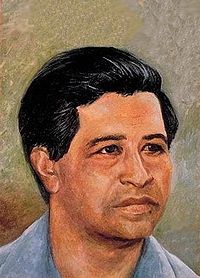
Manuel Gregorio Acosta
Encyclopedia

Mexico
The United Mexican States , commonly known as Mexico , is a federal constitutional republic in North America. It is bordered on the north by the United States; on the south and west by the Pacific Ocean; on the southeast by Guatemala, Belize, and the Caribbean Sea; and on the east by the Gulf of...
, on May 9, 1921. His father, Ramón P. Acosta, had fought in the Mexican Revolution
Mexican Revolution
The Mexican Revolution was a major armed struggle that started in 1910, with an uprising led by Francisco I. Madero against longtime autocrat Porfirio Díaz. The Revolution was characterized by several socialist, liberal, anarchist, populist, and agrarianist movements. Over time the Revolution...
with Pancho Villa
Pancho Villa
José Doroteo Arango Arámbula – better known by his pseudonym Francisco Villa or its hypocorism Pancho Villa – was one of the most prominent Mexican Revolutionary generals....
, and the Mexican Revolution
Mexican Revolution
The Mexican Revolution was a major armed struggle that started in 1910, with an uprising led by Francisco I. Madero against longtime autocrat Porfirio Díaz. The Revolution was characterized by several socialist, liberal, anarchist, populist, and agrarianist movements. Over time the Revolution...
was a recurring theme in Manuel's paintings. The family moved to El Paso, Texas
El Paso, Texas
El Paso, is a city in and the county seat of El Paso County, Texas, United States, and lies in far West Texas. In the 2010 census, the city had a population of 649,121. It is the sixth largest city in Texas and the 19th largest city in the United States...
, United States
United States
The United States of America is a federal constitutional republic comprising fifty states and a federal district...
, in 1924.
Manuel Acosta served in the United States Air Force during World War II
World War II
World War II, or the Second World War , was a global conflict lasting from 1939 to 1945, involving most of the world's nations—including all of the great powers—eventually forming two opposing military alliances: the Allies and the Axis...
, and became an American citizen shortly after discharge. In the fall of 1946 he attended the College of Mines and Metallurgy (now the University of Texas at El Paso
University of Texas at El Paso
The University of Texas at El Paso is a four-year state university, and is a component institution of the University of Texas System. Its campus is located on the bank of the Rio Grande in El Paso, Texas. The school was founded in 1914 as The Texas State School of Mines and Metallurgy,...
), where he studied drawing and sculpture under sculptor Urbici Soler
Urbici Soler y Manonelles
Urbici Soler was a Spanish-born American sculptor and art educator. He is remembered chiefly for Christ the King , a monumental statue of Jesus on the cross atop Mount Cristo Rey in the El Paso suburb of Sunland Park, New Mexico which he completed in 1939 and which is a site of Roman Catholic...
(1890-1953). He then spent a year at the Chouinard Art Institute
Chouinard Art Institute
The Chouinard Art Institute was a professional art school founded in 1921 in Los Angeles, California, by Nelbert Murphy Chouinard .-Founder:...
in Los Angeles and six months at the University of California, Santa Barbara
University of California, Santa Barbara
The University of California, Santa Barbara, commonly known as UCSB or UC Santa Barbara, is a public research university and one of the 10 general campuses of the University of California system. The main campus is located on a site in Goleta, California, from Santa Barbara and northwest of Los...
, before establishing his home and studio in El Paso, Texas
El Paso, Texas
El Paso, is a city in and the county seat of El Paso County, Texas, United States, and lies in far West Texas. In the 2010 census, the city had a population of 649,121. It is the sixth largest city in Texas and the 19th largest city in the United States...
.
He was bludgeoned with a lead pipe and murdered on October 25, 1989 by a drunken Mexican national and is buried in the United States at Fort Bliss National Cemetery
Fort Bliss National Cemetery
Fort Bliss National Cemetery is a United States National Cemetery located in the United States Army post of Fort Bliss, in El Paso County, Texas. It encompasses , and as of the end of 2005, had 42,141 interments.-History:...
.

